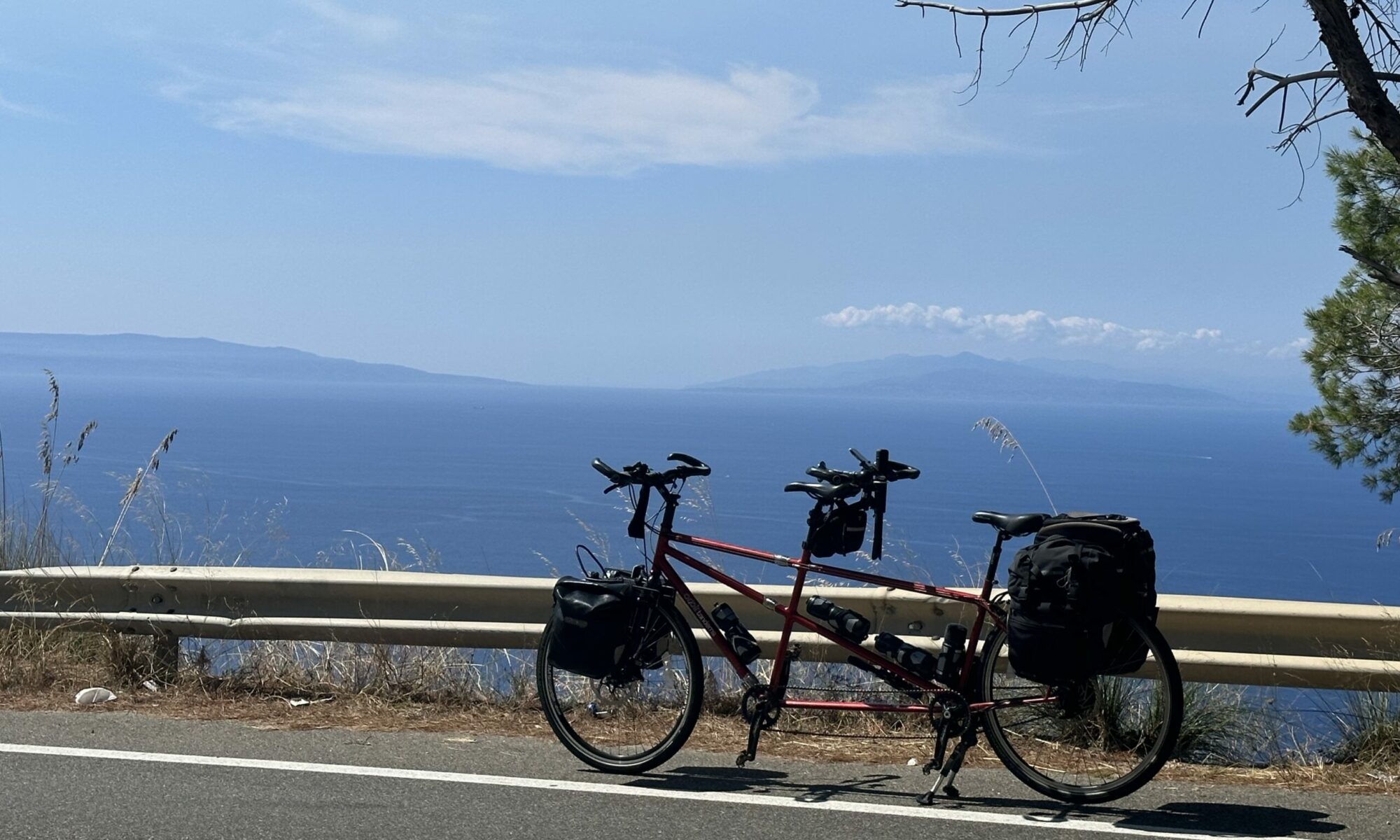Day One
We’ve never been to India before. We had planned to visit some years ago en-route to Sri Lanka, but the flights didn’t worked out, so we left it on our long and ever-growing list of places we’d like to visit in the future.
So it was with a sense of excitement that we arrived at Indira Ghandi airport in the early morning fog/smog. We couldn’t see much during landing; in fact it was quite a surprise when the wheels hit the tarmac as we hadn’t realised we were so close to the runway. On walking into the terminal we noticed that it was smoky, and the taste of the air slightly acrid.
So let’s get the negative aspects out of the way early on! Delhi is unbelievably crowded, with a population of 23 million (or 2.3 crore, if you use India’s interesting numbering system). It is one of the most badly polluted cities in the world. The traffic is ridiculous, there is poverty, squalor, and there are beggars on the streets almost everywhere.
And yet, and yet… Perhaps because we’re both “glass half-full” people, and perhaps it was the excitement which comes with a new country, we were captivated early on, and we continue to be so, some days later.
The journey into our hotel in New Delhi was a fine introduction to the contradictions of the Indian experience. If you’ll forgive the cliché, it was an all-out assault on the senses. There were constant traffic jams; ridiculous driving manoeuvres; tuktuks coming from all directions. Almost every vehicle bore the marks of previous encounters – some of the buses, in particular, seemed to consist entirely of battered panels.
By the side of the road there were monkeys, some sitting and gazing into the distance, some searching for food. Cattle wandered in and out of the traffic, and received far more respect from the drivers than that granted to the other occupants of the road. There were bicycles too, some loaded up with ridiculous burdens – we saw one carrying at least eight propane canisters, presumably empty.
We passed through the diplomatic sector, embassy-spotting, and eventually arrived at our hotel, where we raced through the formalities as quickly as possible before retiring to our room for some much-needed sleep. We awoke, with the assistance of an alarm, in the late morning, showered and had time for a buffet lunch which included a beautifully fragrant biryani, before meeting our driver in the lobby. We had booked an afternoon tour to Akshardam temple, a modern construction but built in the classical Hindu style from Carrara marble and soft red Rajasthani sandstone. It’s one of the biggest temple complexes in India.
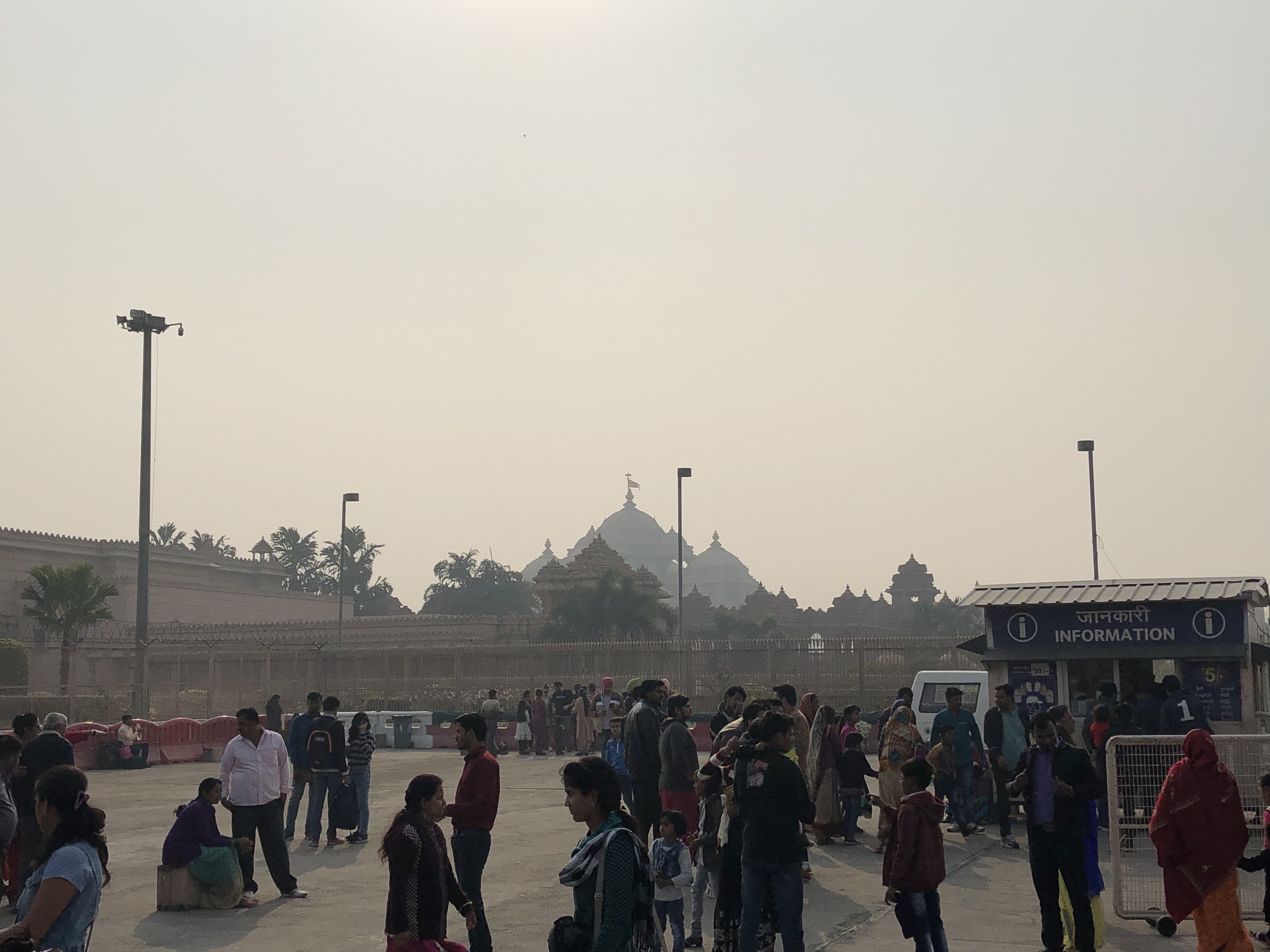
The smog had lifted somewhat, and when we were dropped off at the entrance we joined the entry queue. It seemed to us that we were virtually the only “western” visitors, and as such we were the object of interest to many of the Indians in the queue. We soon discovered, too, that personal space is much more narrowly defined here – we all crushed together, cheerfully, in the gender-separated line-ups for the security scanners.
There was a long list of prohibited items in the sign above the entrance, and since it included cameras we were unable to take our own pictures within the complex. So here’s one I downloaded earlier!
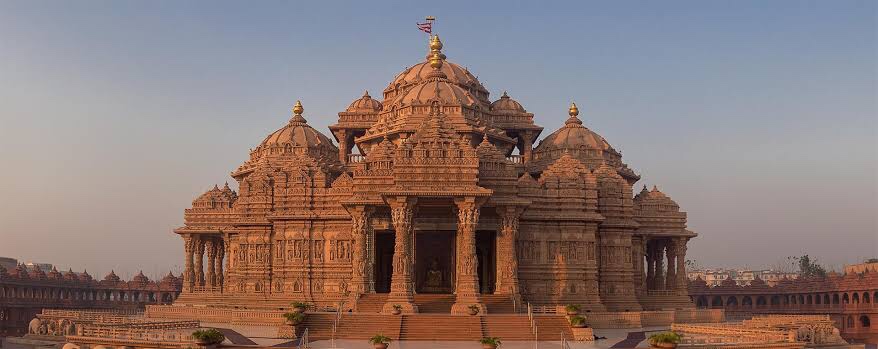
The temple was lit now by a hazy sun, and very striking. We wandered the grounds first, past tableaux of Indian heroes and heroines, before heading into the temple proper, surrounded by low red sandstone colonnades. Removing our shoes we went inside, admiring the intricate carvings and trying to recognise the Hindu deities familiar from previous visits to Sri Lanka and Mauritius. The temple was fairly crowded, but with smiling faces everywhere. Already, though, we were flagging somewhat, after the long flight, and reluctantly we returned to the car park for the short journey back to our hotel.
The LaLit hotel adjoins Connaught Place, a place of colonnades and a foodie destination. In the evening, therefore, we didn’t have to walk very far to find what turned out to be an excellent restaurant. Communication was a bit tricky, as they didn’t speak much English and of course our Hindi is non-existent. Anyway, we managed to establish that we could choose between being identified as “Veg” or “Non-Veg”! Having selected the latter, we sat at our table while a selection of delicious appetisers arrived. One of the in particular comes to mind – a hollowed out lemon, which had been crisped in the oven and was served with spices and yoghurt – it was delicious. We were also given chilli garlic fish and some deep-fried chickpeas. Then the waiter removed a portion from the middle of our table and replaced it with a charcoal grill, and our “Non-veg” skewers arrived – Chicken and mutton tikka, Garlic prawns, Lamb spiced with cardamoms – there seemed to be an endless supply and we tucked in until we could manage no more…
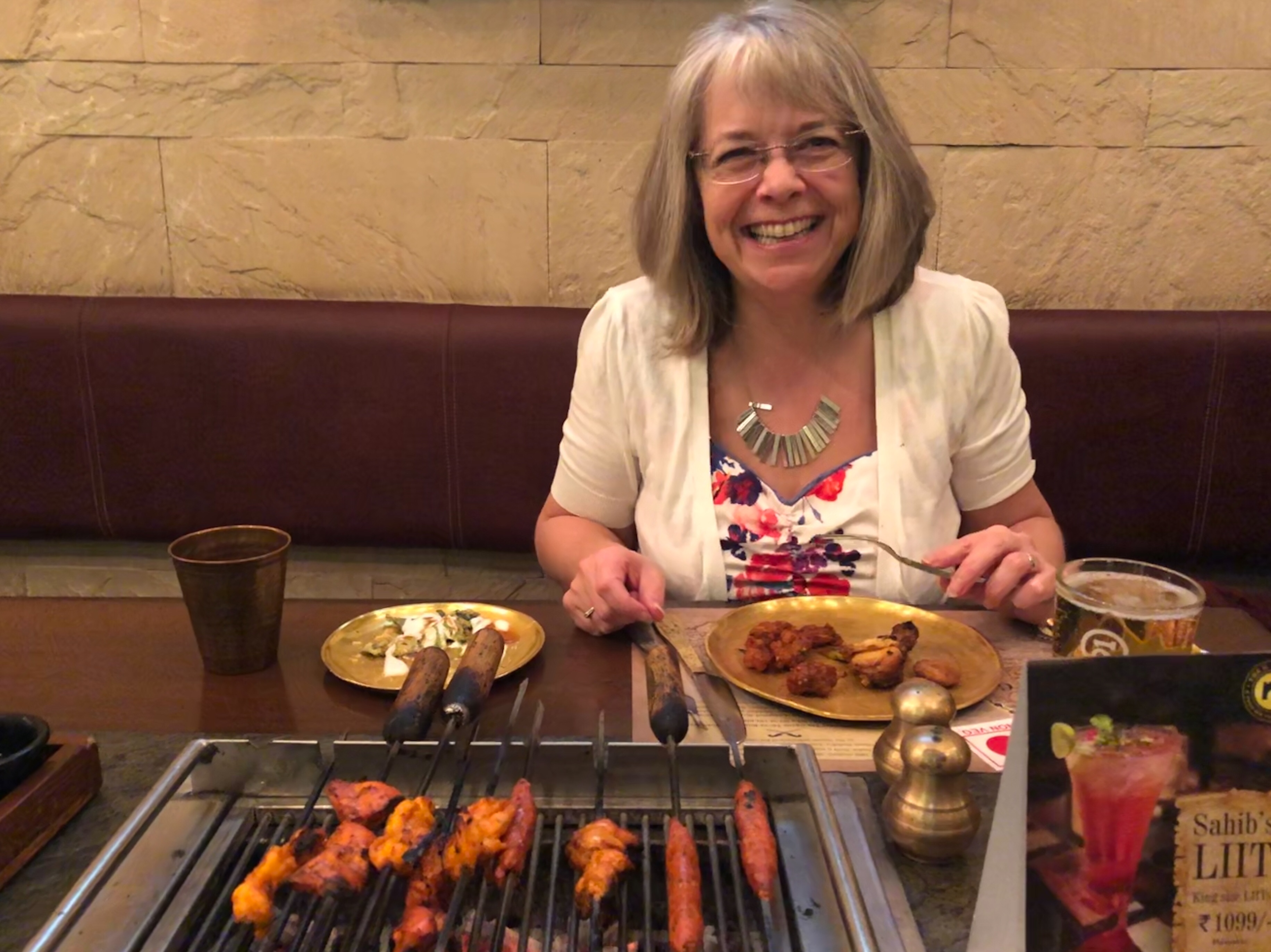
…which was a mistake! Just as we were about to request the bill the waiter pointed to the end of the restaurant, and asked us to help ourselves to the main course buffet. Reader, we tried! It was a token effort though, and we managed only a small portion of delicious food accompanied by a shared garlic naan before admitting defeat! I don’t think the waiter was very impressed with our effort. What we did manage to eat, though, was utterly delicious!
Day two
On our second day the travel company had organised a half-day tour. We had a new driver now, Ramesh, who was to look after us for the next few days in India. He was an unflappably calm driver, who made us feel safe throughout, and on the days when we weren’t accompanied by guides, pointed out salient features along the route. We liked him immensely. The guide, too, was excellent. Our first visit was to the tomb of Humayun. The smog had descended again overnight, but combined with the early morning sun it was actually very atmospheric as we toured a complex which was said to have inspired the later building of the Taj Mahal.
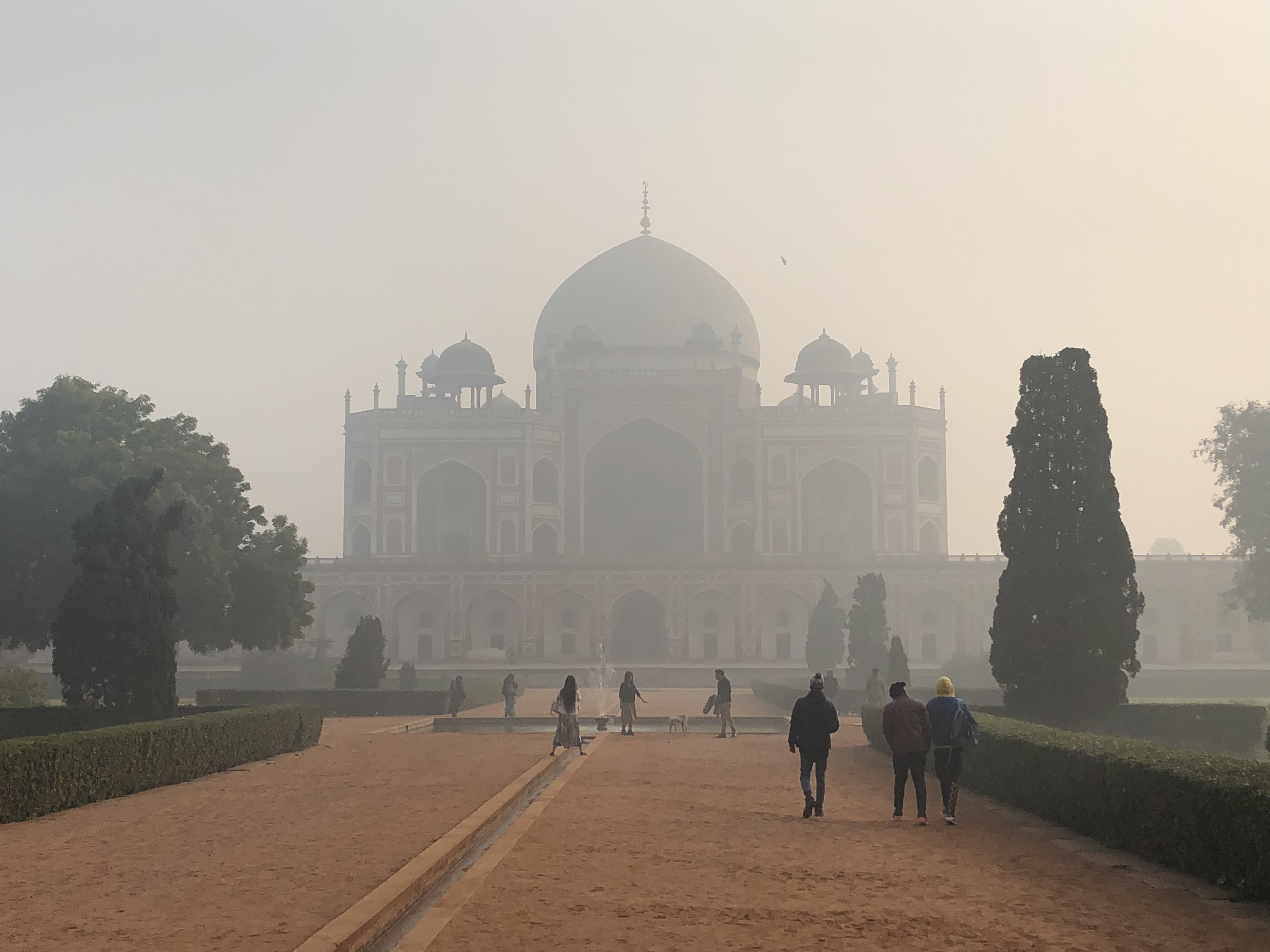
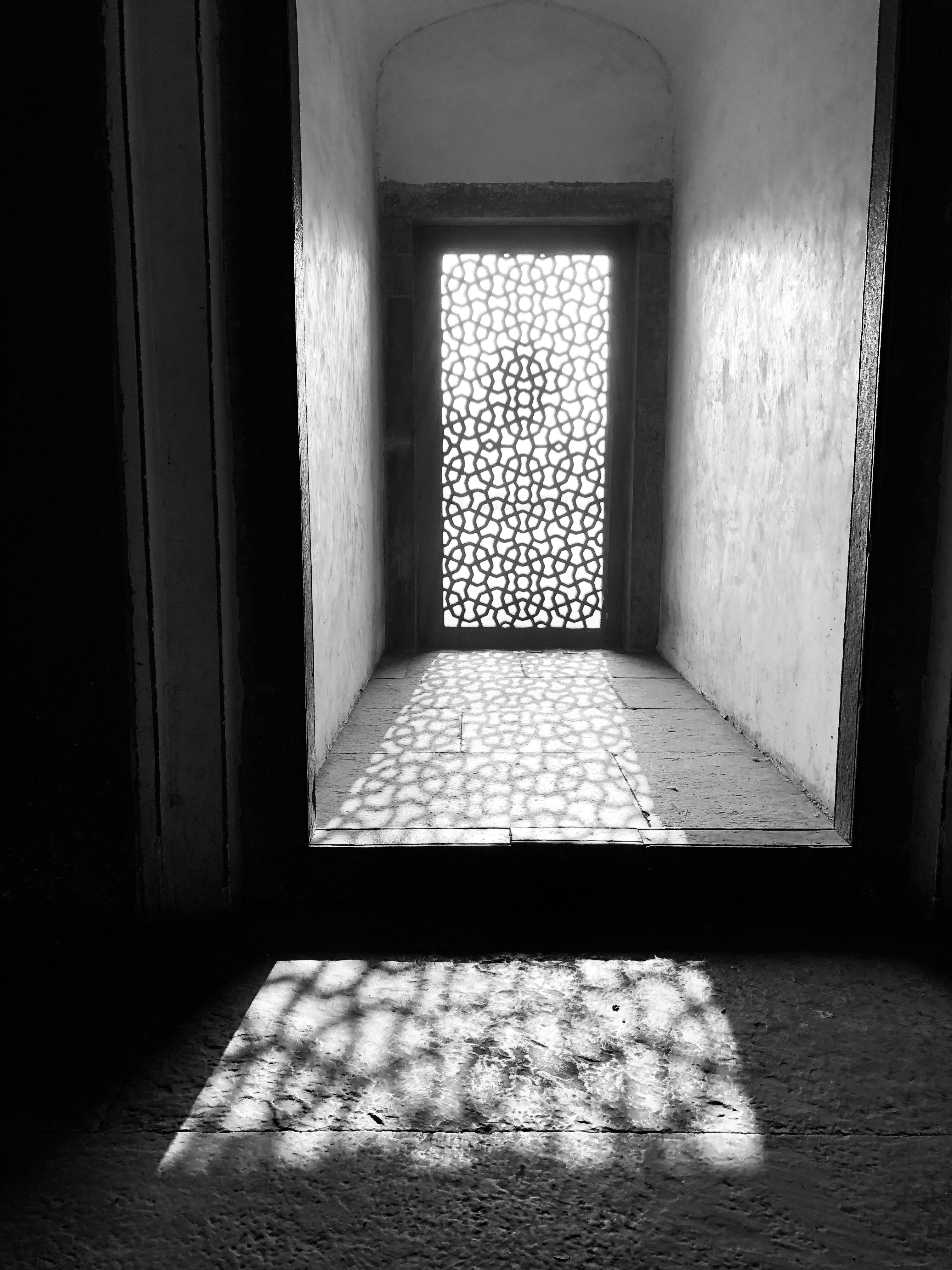
Humayun was a Mughal ruler in the 16th century, and apparently a prolific consumer of opium who lost his empire early on then regained it with the help of the Persians. The tomb was commissioned by his wife, and is an elegantly symmetrical construction in marble and Rajasthani sandstone. It is surrounded by elegant water-gardens, and the tombs of (among others) his nanny and barber!
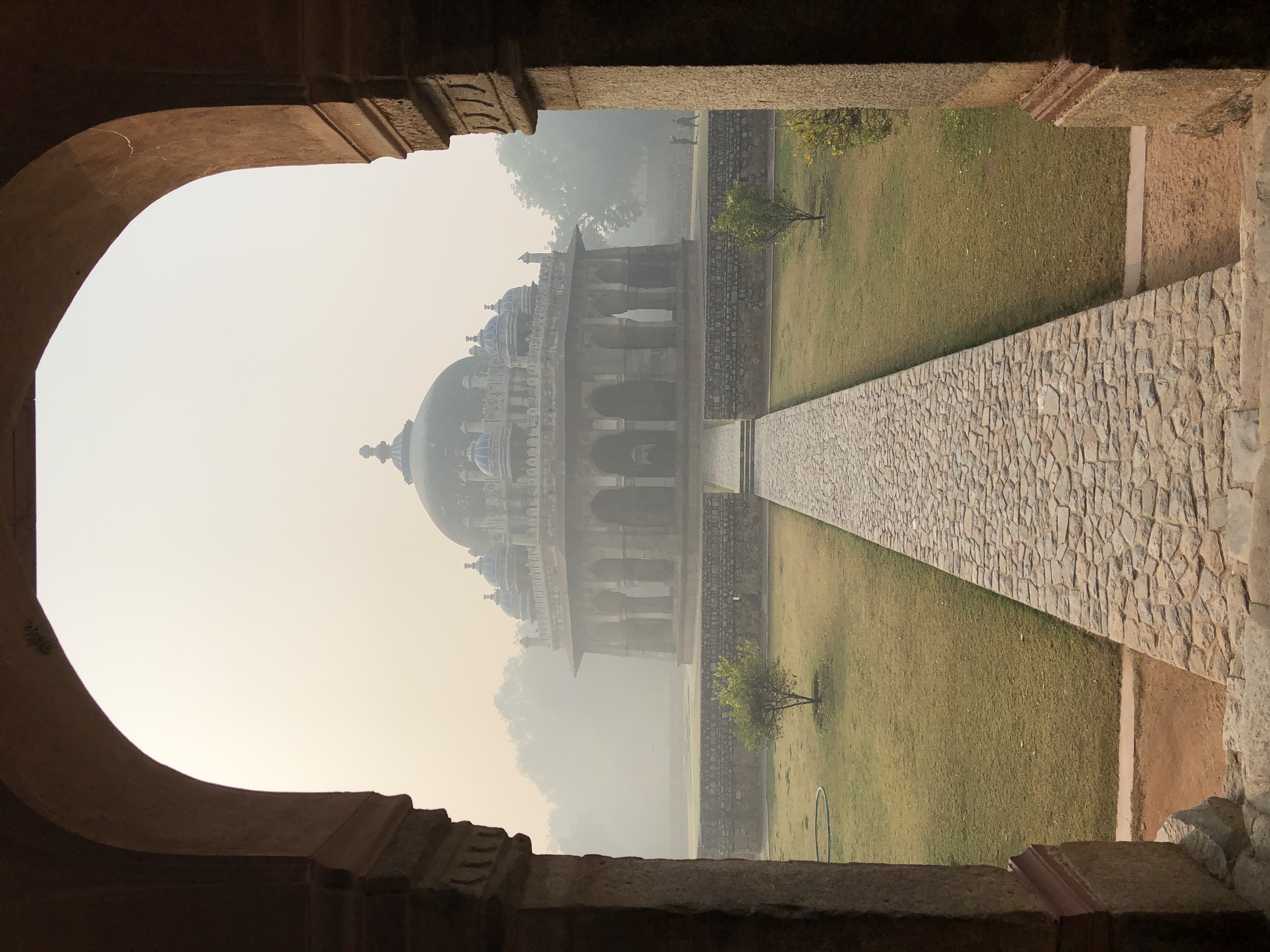
All of this was explained in detail by our guide. His knowledge was encyclopaedic. Every now and then, though, his eyes would grow misty and he would repeat the same phrase, two, three or even four times, with long pauses in between, before he remembered what he wanted to say next.
To a Hindu temple, next, shoes off again, and our foreheads marked with bright orange paste before we toured the temple, strictly in a clockwise direction at the guide’s instruction. Every niche was occupied by one or more deities – Shiva, Vishnu, Ganesh and many more, some with their travel guides – a swan, an owl, or perhaps a tiger. In the middle of the temple a vibrantly noisy form of worship was taking place, and when we reached this part our guide joined in the enthusiastic call-and-response with fellow worshippers. It all seemed very cheerful, more celebratory than reverent.
Onwards, then, to Jama Masjid – the country’s largest mosque, magnificently situated on a hill, looking down towards the Red Fort. Again we have no pictures as they wanted to charge for the privilege, and we’re from Yorkshire! It is an ‘open’ mosque, largely outdoors, and strikingly different from the Hindu style particularly in that Islam forbids representations of humans or animals, so all of the decoration is in the form of geometric patterns. Again, we had to take off our shoes and this time in addition we had to wear wraps to cover our knees – these were delightfully fashionable (not!).
We moved on to Chandni Chowk (Silver Street), for a rickshaw ride which we initially feared might be a bit ‘Flamenco for foreigners‘. In reality, though, it was simply the best way to navigate the crowded narrow streets of old Delhi, hands firmly inside the bars of the rickshaw.
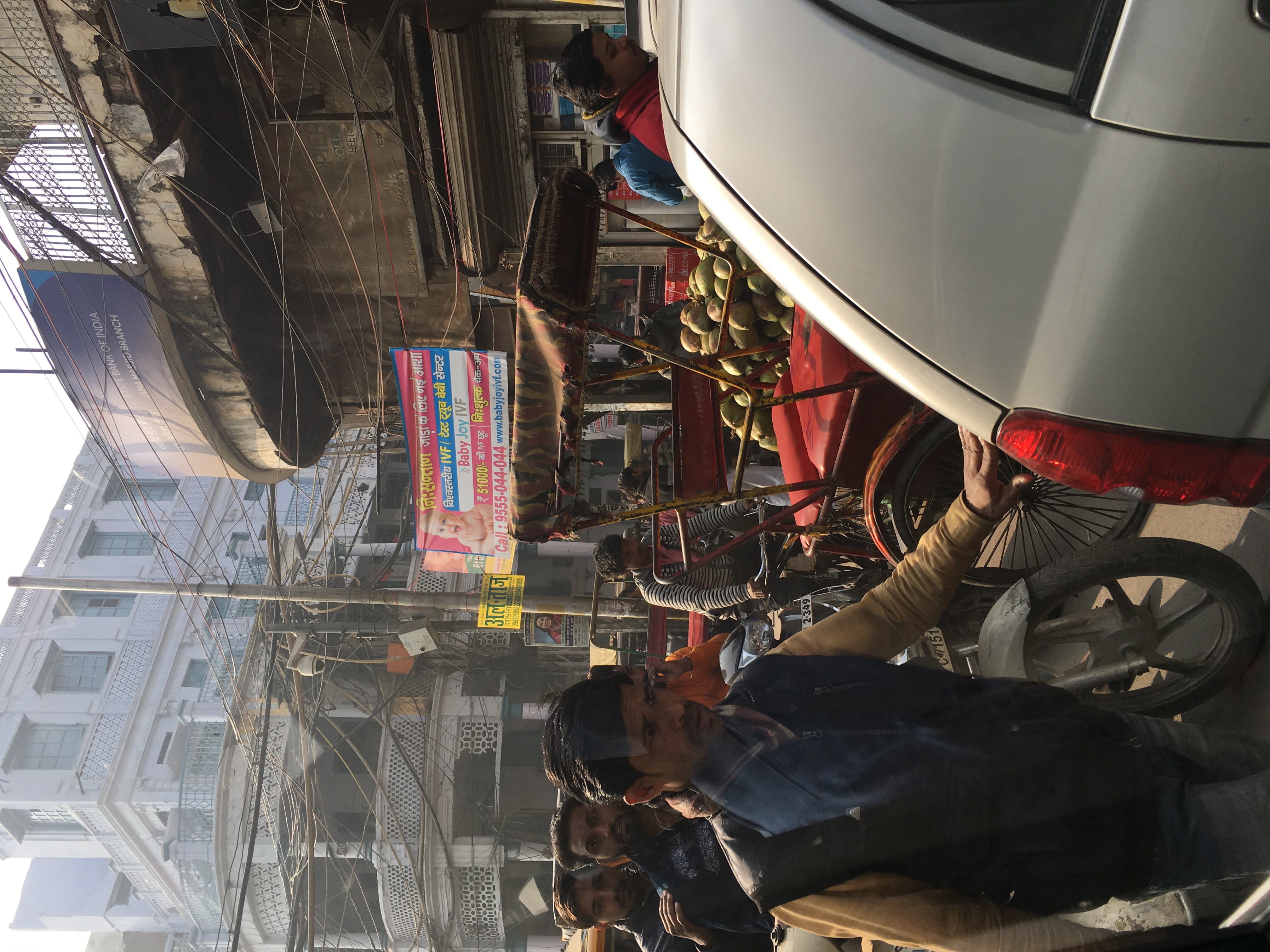
There were deep potholes everywhere, and the streets where a chaotic riot of colour, featuring markets for all types of produce and electrical wires cris-crossing the streets. Our rickshaw river took no prisoners, fighting his way through the busy streets berating anyone who got in his way.
There then followed a calm interlude, as we visited Raj Ghat, the site of Mahatma Ghandi’s cremation on the banks of the Yamuna river. It’s a simple black stone monument, surrounded by elegant and well-kept gardens, and bearing an eternal flame.
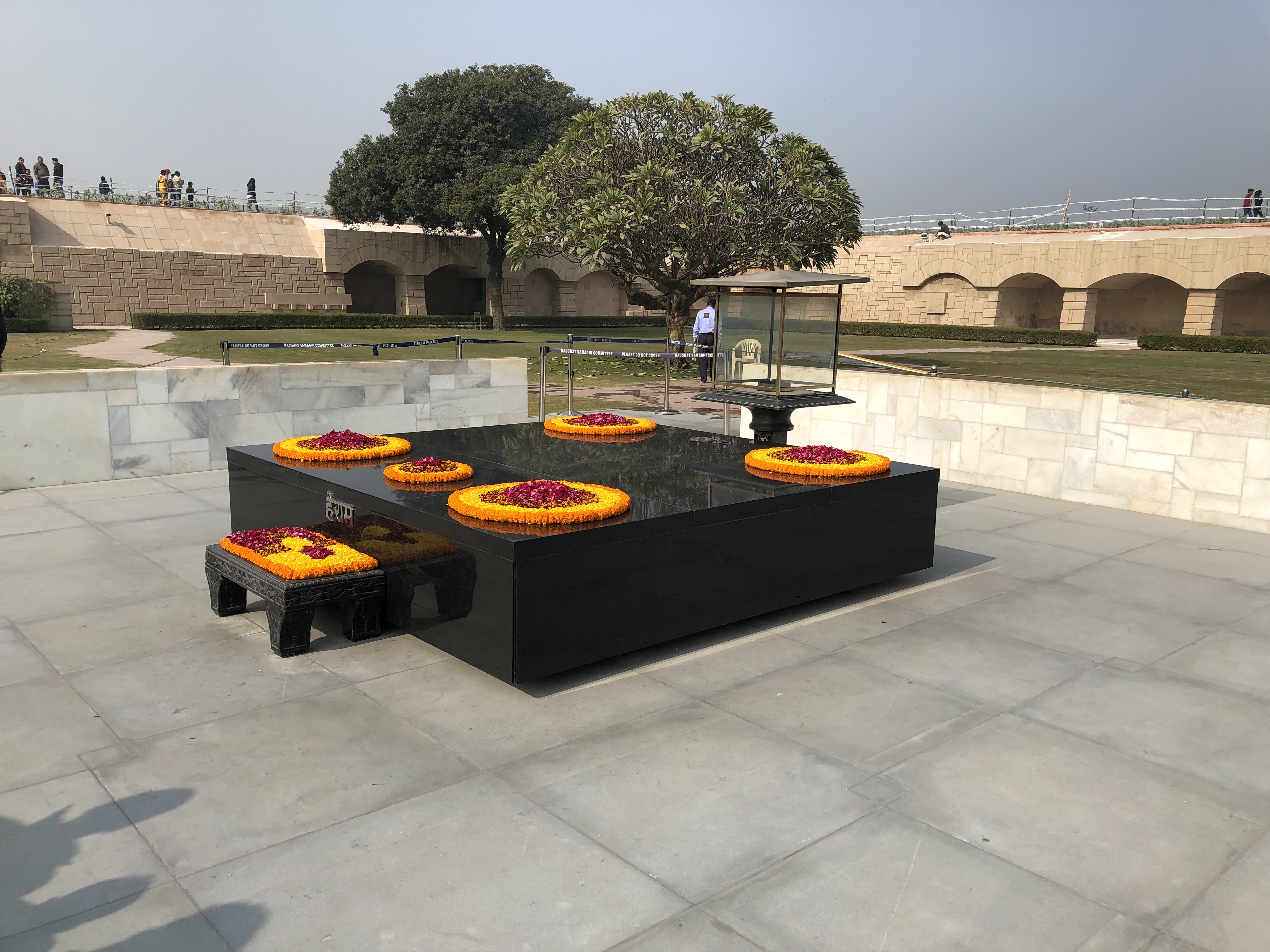
Finally we visited Gurudwara Bangla Sahib – Delhi’s largest Sikh temple, a gold and white building complex. Our guide explained that one of the tenets of the Sikh religion is to feed anyone who needs or even just wants food. In the complex, therefore, was a huge dining hall supported by an efficient kitchen providing a constant stream of dishes containing Dal and Chapattis to multiple rows of people.
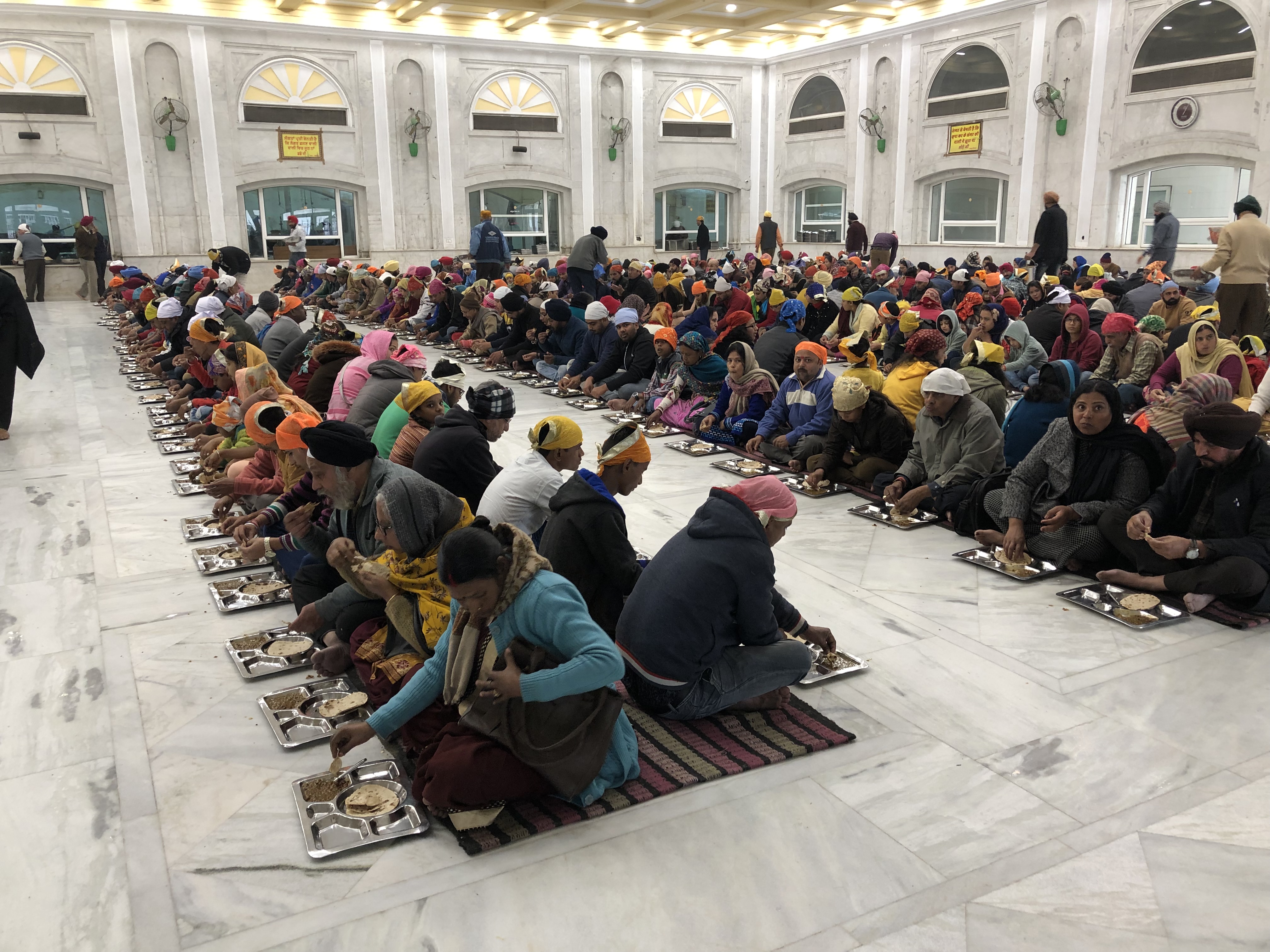
The kitchen featured enormous cooking pots and a team of five people dedicated to chapatti production. The food smelled fantastic!
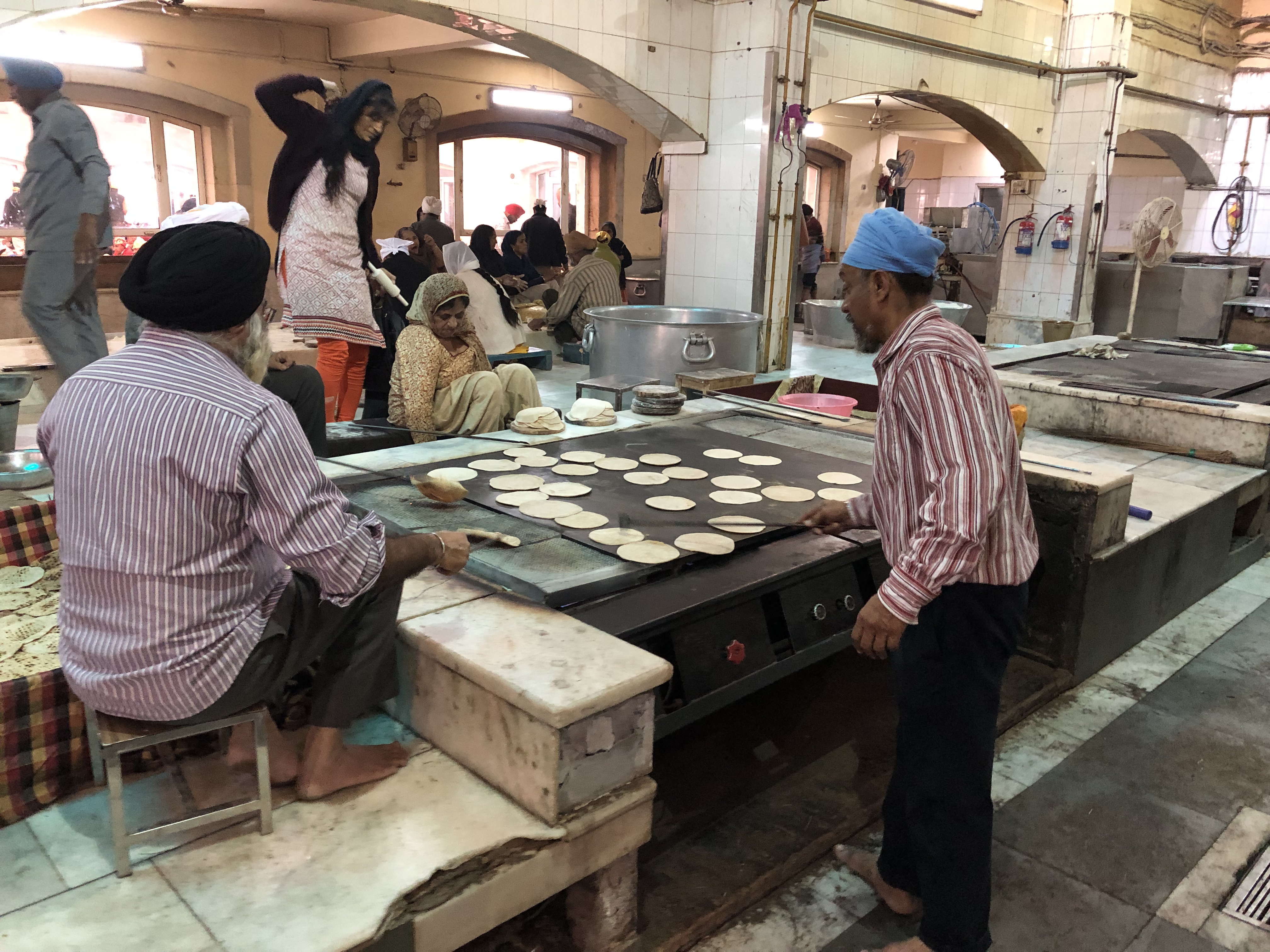
The temple itself was white, yellow and gold on the exterior, with plenty of gold in the interior, and featured three musicians singing religious songs. Again we had to take off shoes and wear a head covering, Clare managing successfully to avoid the orange ones.
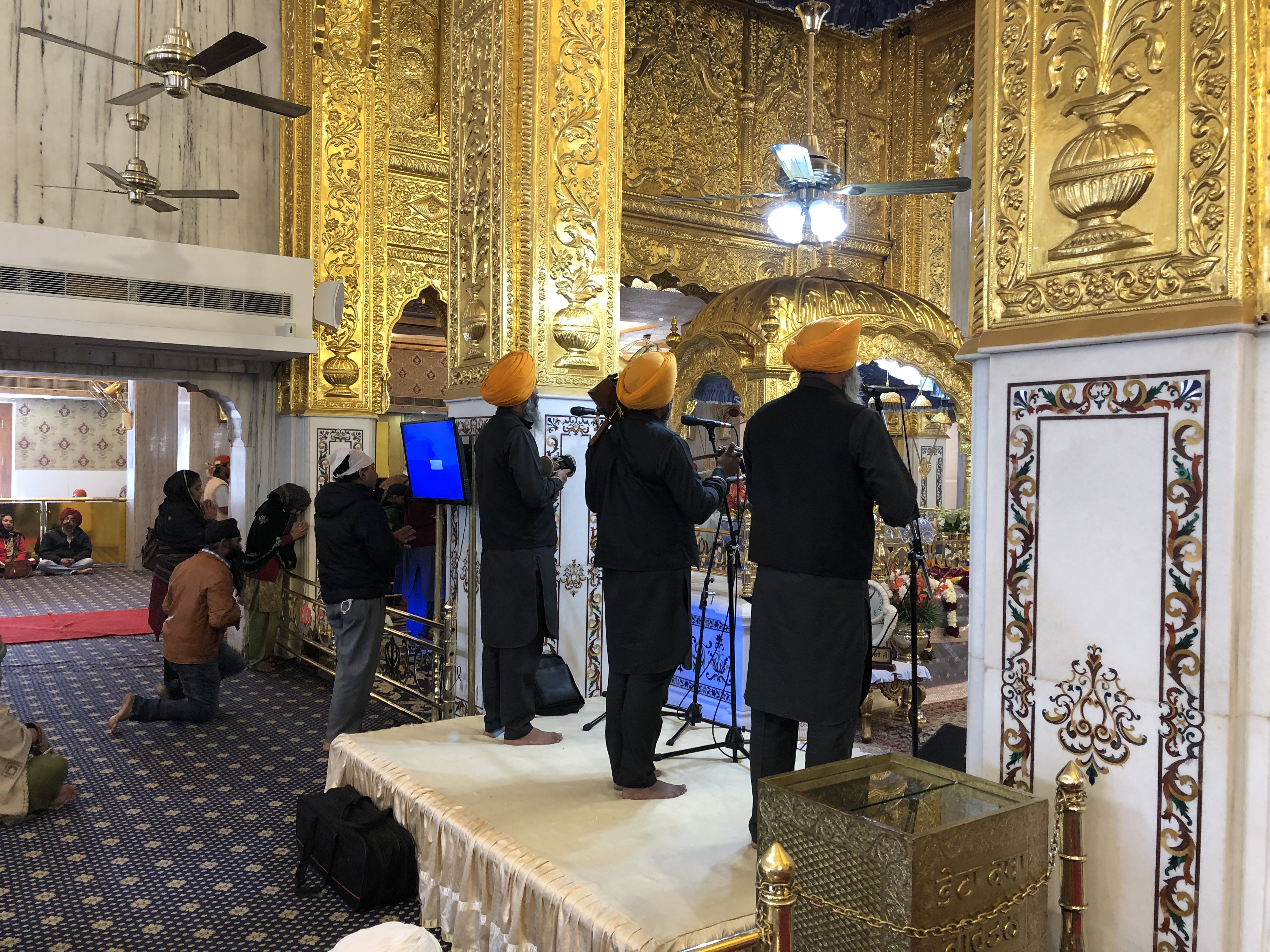
That was the end of the tour, but the guide then took us for lunch at Pindi’s, which was clearly a favourite with the tour guides, and it soon became obvious why. We had superb Butter Chicken, Dal, Roti and Garlic Naan, and friendly chat with two guides and some fellow Brits. Outside in the car park a snake charmer (with accompanying cobra) was plying his trade.
After such a busy day we enjoyed a quiet night in at the hotel’s “Baluchi” restaurant, particularly enjoying delicious lamb rack starter, which had clearly been marinated for some time, and had absorbed some amazing flavours.
Day Three – Delhi to Jaipur
In the morning, Ramesh picked us up early for our journey to Jaipur. There seemed to be a temperature inversion, and the smog was thick and acrid. This remained the case for the first hour and a half of our five hour journey.
As we were leaving the city in the rush hour there seemed to be a competition going on – how many people can fit in one tuk-tuk? I counted at least eight on more than one occasion, but Ramesh says that sometimes people hang on to the sides as well. He also said that there are only three things you need as a driver in India – a good horn, good brakes, and good luck!
As the road passed through more rural areas we saw camels, some baboons and a single elephant, working in the fields. Oh, and many cows who seemed to know they had priority in all circumstances. We lunched just outside Jaipur, where Clare indulged her growing addiction to all types of Dal by enjoying a fine black lentil preparation.
